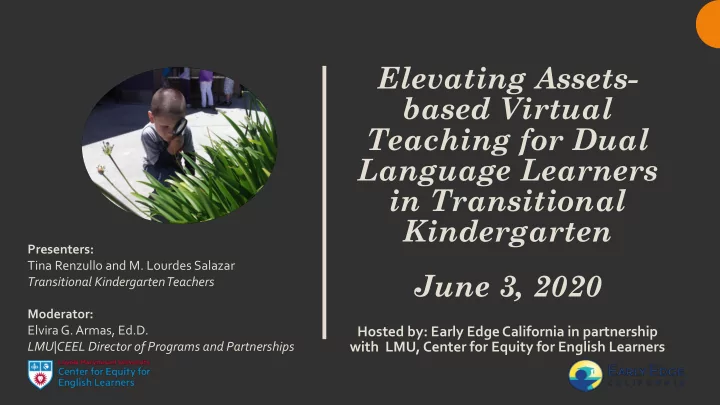

Elevating Assets- based Virtual Teaching for Dual Language Learners in Transitional Kindergarten Presenters: Tina Renzullo and M. Lourdes Salazar June 3, 2020 Transitional Kindergarten Teachers Moderator: Elvira G. Armas, Ed.D. Hosted by: Early Edge California in partnership with LMU, Center for Equity for English Learners LMU|CEEL Director of Programs and Partnerships
Welcome Early Edge California Carolyne Crolotte, Senior Policy Analyst
➢ Reflect on design principles for equitable distance learning for Dual Language Session Learners in Transitional Kindergarten (TK) Goals and similar early childhood settings ➢ Identify classroom-based strategies to elevate student and family assets and support social and emotional needs during distance learning ➢ Explore intentional instructional design ideas to promote oral language development and deliver Integrated ELD
Transitional “ This is a dynamically Kindergarten evolving timeframe. I can carry some of Teacher Tina Renzullo these learnings back Transitional Kindergarten Teacher Insights with me when we George C Marshall Elementary School Monterey Peninsula Unified School District return to the classroom. ” TK/ECE Certificate Program Instructor LMU, Center for Equity for English Learners Maria Lourdes Salazar Transitional Kindergarten Teacher Willow Elementary School Los Angeles Unified School District National Board Certified Teacher, 2017 “ The biggest thing with early age students is that they know we are still connected. We are still the TK family! ”
FROM RESEARCH TO PRACTICE Explicit Goals & Outcomes: -Focus Standards -Addressing the Digital Divide -High Tech/Low Tech Meaningful Connections & Engagement -Family Connections -Social and Emotional Needs Maximum Comprehensibility -Prior learning -Oral language development -Primary language Varied Participation Structures -Independent, class, and family activities Differentiated Reflection and Assessment -Virtual and actual artifacts -Metacognition
For whom am I designing distance learning?
What are my overarching goals for student learning during this time frame?
When & Where? Daily Routines & Expectations
Keeping the “why” central to all efforts
TK Teacher Collaboration Developmentally Appropriate Curriculum Socio- Communication emotional - Digital Platforms Learning - Phone calls - Messages Language Arts -Reading Music - Writer’s Workshop MEANINGFUL INTERDISCIPLINARY TEACHING ENGAGEMENT and LANGUAGE DEVELOPMENT Art Science Asynchronous Modes - Digital Learning Synchronous Modes Platforms - Zoom - Packets - Phone - Materials - Messages CGI Math District Distance Learning Continuity of Routines Requirements Familiarity of Materials 240 minutes of instruction daily (mixed modes)
Weekly Schedule •Co -created • Flexible • Supportive
Social and Emotional Learning
Social and Emotional Development: Relationships, Self-awareness, Self-management Bridging the shift from classroom to distance learning Thematic Study Classroom Connections Reread Favorite Books Family Supplies from School Partnerships Puppets
Social and Emotional Development • Creating new points of connection • showing me in my home during lesson videos • shared photos and videos in Google Classroom • Sharing art and math and science projects in live meetings • Looking and listening for cultural experience, learning behaviors, self- confidence
Social and Emotional Development • Relating positivity along with understanding • daily questions prompting reflection and response • live meetings to maintain positive relationships with others • Keeping parents and students engaged
Messages SEL Support I knew the only way to Intentaremos nuevas attempt to be successful with cosas, y sí no distance learning was to have funcionan no las parental support. Aprendiendo en distancia usaremos . es nuevo para todos Who would the child be with incluyendo para mi. during the day? When was the student going to complete the work? Lo único normal que les queda de su escuela son How were parents going to be sus amigos y sus able to help their child? maestras.
Social-Emotional Needs Self awareness in the New Space of Distance Learning • Growth Mindset – parents and students • Flexible and responsive to family needs • Building self confidence of both parents and students • Sent messages – text/video • Listened to understand needs • Working from assets of parents and students
Relationship Skills • Build new trust • Communication with each other • Teamwork • Sharing Time
Participant Reflection • What are three key strategies for supporting social and emotional needs through leveraging family partnerships? • What other strategies have you implemented in distance learning?
Oral Language Development and Integrated ELD
Funds of Knowledge Resources, assets, values, and experiences of home Members of the household Language Supports schema building
Read Alouds Interactive Stop and model thinking Ponder interesting questions Highlight features of text Rich in content General and specific vocabulary Ideas worth discussing Positive socio-emotional climate
Support higher level questions with prompts • Open-ended questions • Think time • Ask for details • Build onto what is spoken • Converse back and forth • Expect and use complete sentences
Question Prompts for Parent Use
Integrated ELD Cognitively Guided Instruction Subitizing Counting Collections Number Sense One to one correspondence Understand quantities Multiple forms of representation High levels of addition Oral language development
What Do You Notice?/ Problem Solving Oral Language Development Builds critical thinking skills Solution through pictures Practice mathematical strategies
Cognitively Guided Instruction Steps of Think Aloud Problem Solving – Think Aloud 1. Read the problem. 2. What do we know? Problem Solving Video 3. What is the question? L. Salazar 4. What strategy will I use? 5. Organize my thinking so others can understand it. 6. Answer the question.
Model Developing Oral Language Sentence Language is key Frames Development and Critical Thinking Model Guide Critical Talk out the Thinking problem
Participant Reflection • How can oral language development be bolstered in your distance learning design? • What strategies are used to support Integrated ELD?
Visit the LMU, Center for Equity for English Thank you! Learner’s Website for more resources: English Learner Supports during COVID-19 https://soe.lmu.edu/centers/ceel/englishlearnersupportsduring covid-19/ Contact information: Transitional Kindergarten/Early Childhood Education Certificate ceel@lmu.edu https://soe.lmu.edu/centers/ceel/professionallearning/certifica te/transitionalkindergartenteachingcertificate/ info@earlyedgecalifornia.org Dialogic Reading for Teachers of Dual Language Learners Online Modules https://soe.lmu.edu/centers/ceel/resources/earlychildhoodengl ishlearnersresources/
Recommend
More recommend